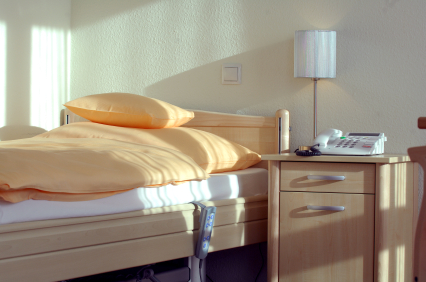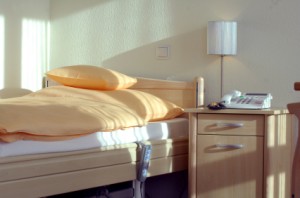 To decrease the chances of an infectious illness spreading and infecting other household members, it is important that every effort be made to keep the illness in a contained area. A sick room in the home can achieve this, as well as assist in limiting the number of people who have close contact with the sick person.
To decrease the chances of an infectious illness spreading and infecting other household members, it is important that every effort be made to keep the illness in a contained area. A sick room in the home can achieve this, as well as assist in limiting the number of people who have close contact with the sick person.
Characteristics of the Ideal Sick Room
To ensure that the sickness is as contained as possible, set up the sick room in a bedroom or another separate room in the house. Ensure that the room has good lighting, a window that opens, and easy access to a personal bathroom with a sink and running water. Further, to err on the side of caution and make sure the illness is not spread into other parts of the household, create a secured area using plastic sheeting on the outside of the room to remove clothing and items worn inside the room. A trash can can be added to discard items.
Prevention is Key
To avoid other family members falling ill, limit the exposure of people coming into the sick room. This includes making sure that any communal areas (kitchen, bathroom, etc.) be thoroughly cleaned with disinfectant each day to avoid the transmission of germs. Towels, water bottles, drinking glasses, and other personal care items used by the sick person, should not be used by other family members.
To further safeguard your home and the occupants inside the home, have all necessary supplies and items for the sick room present beforehand. By doing so, will reduce the likelihood of contaminating other members and areas of the household, make for easy accessibility, as well as provide a more controlled environment.
Similar to other emergencies we simply prepare as much as we can because any steps taken toward preparedness are better than none at all. That said, due to the erratic nature of pandemics, it is vital to have all supplies ahead of time to avoid any exposure. In the preparedness manual, The Coronavirus Preparedness Handbook [1], the chapter on pandemic preparedness lists a few ideas to consider on how to better prepare for family for this type of emergency:
-
- Taking proper illness precautions – avoid touching your mouth, nose and eyes during any pandemic.
- Create a sick room [2] for the home.
- Keep your immune systems up by getting lots of sleep, regularly exercising, having a proper diet, and taking vitamins to better protect your health.
- Stay inside and avoid contact with others.
Consider these 10 preventative measures:
- Line a mattress with plastic sheeting to prevent bodily fluids from soaking in.
- All tissues, utensils, equipment, bedding, and clothing in contact with the sick person should be handled as if the germs of the illness were on them. Dishes and equipment should be washed in hot soapy water or wiped with 10% bleach or other disinfectant.
- Use disposable dishes when possible so they can be discarded in garbage bags in the sick room.
- Place all used tissues directly into a zip-loc plastic bag that can be closed at the top before leaving the sick room. Have alcohol-based hand cleaning solution (Purell [3]) at the bedside so the person can wash their hands after they cough or sneeze.
- Gently fold or roll clothing and bedding into a plastic bag, being careful not to shake them, possibly releasing the germs into the air. Clothing and bedding should be washed in hot water.
- Clean items in the room with a 10% bleach solution (made by combining 1 ounce of bleach with 9 ounces of water) or other disinfectant. Clean bathroom faucets and sink with 10% bleach or disinfectant wipes after the sick person has used them.
- If you do not have a Tyvek protective suit [4], wear a raincoat or other washable gown/coat over your clothes when in the room caring for the sick person. This gown will help to protect you from getting the germs on your clothes while caring for the person. This should stay in the room. Further, consider purchasing shoe covers [5] for your feet to prevent the illness from spreading.
- Wash your hands or use a alcohol-based cleaning solution (Purell) on your hands every time you leave the room. If disposable gloves are available, they can be worn while in the room but they should be removed in the room and discarded in the room, and then your hands must be washed.
- Depending on how infectious the disease is, limit the people in close contact (within 6 feet) of the sick person. Keep the door to the sick room closed. Have a bell or cell phone by the bedside so the person can call for assistance when needed.
- If respiratory masks (N95 masks [6]
) are available, they should be worn by the sick person and the caretaker when they are in close contact.
Some items to consider when stocking a sick room are:
- Tyvek protective suit [4] and shoe covers [5]
- Plastic sheeting [7]
- Bed with linens, pillow and blanket
- Small wastebasket or a bucket lined with a plastic garbage bag.
- Gallon-sized zip-loc bags
- Pitcher or large bottle for water
- Large plastic dishpan
- A portable toilet [8]
and human waste bags [9]
- Clipboard with paper and a pen for writing in the daily log.
- Clock
- Hand crank or battery-powered radio
- Good source of light
- Flashlight with extra batteries
- A clothes hamper or a garbage can lined with a plastic garbage bag can be used to collect soiled clothing and bedding items before they are washed.
- A bell or a noisemaker to call for assistance.
- Thermometer
- Tissues
- Hand wipes or a waterless hand sanitizer [3]
- Bleach or disenfectant
- Cotton balls
- Rubbing alcohol, disinfectant or bleach
- Measuring cup capable of holding 8 ounces or 250 ml
- Over-the-counter medications for use in the sick room
- Protective eye gear
- Protective clothing [10]
- Disposable aprons or smocks [11] (at least 2 cases)
- Duct tape [12]
for sealing off doorways and vents
- Latex household disposable cleaning gloves [13]
- Disposable nitrile gloves
(2-3 boxes)
- Garbage bags [14]
- Trash can
- N95 masks
[15] or N100 respirator masks [16] for use when the sick person is coughing or sneezing (can be purchased at hardware stores and some drugstores)
To prepare for longer-term scenarios, consider adding other medical supplies [17] to the sick room. Further having some medical response packs [18] pre-packaged cuts down on response time, and gives the caregiver more of an advantage in properly caring for the wounded.
To prepare for an SHTF scenario [19], it would be beneficial to take into account the most likely medical situations [20] you may come in contact with and plan accordingly.
Preventing the transmission of an illness can be done with proper planning and preparation. A little forethought will help the caregiver be as efficient as possible in treating the ill patient, and in the process, keep the rest of household as healthy as possible.
Sections of this article were adapted from the book Pandemic Home Care [21]
